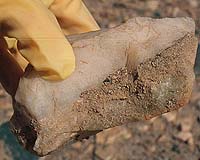 |
San Diego CA (SPX) Mar 23, 2011 Stanley Miller gained fame with his 1953 experiment showing the synthesis of organic compounds thought to be important in setting the origin of life in motion. Five years later, he produced samples from a similar experiment, shelved them and, as far as friends and colleagues know, never returned to them in his lifetime. More 50 years later, Jeffrey Bada, Miller's former student and a current Scripps Institution of Oceanography, UC San Diego professor of marine chemistry, discovered the samples in Miller's laboratory material and made a discovery that represents a potential breakthrough in the search for the processes that created Earth's first life forms. Former Scripps undergraduate student Eric Parker, Bada and colleagues report on their reanalysis of the samples in the March 21 issue of Proceedings of the National Academy of Sciences. Miller's 1958 experiment in which the gas hydrogen sulfide was added to a mix of gases believed to be present in the atmosphere of early Earth resulted in the synthesis of sulfur amino acids as well as other amino acids. The analysis by Bada's lab using techniques not available to Miller suggests that a diversity of organic compounds existed on early planet Earth to an extent scientists had not previously realized. "Much to our surprise the yield of amino acids is a lot richer than any experiment (Miller) had ever conducted," said Bada. The new findings support the case that volcanoes - a major source of atmospheric hydrogen sulfide today - accompanied by lightning converted simple gases into a wide array of amino acids, which are were in turn available for assembly into early proteins. Bada also found that the amino acids produced in Miller's experiment with hydrogen sulfide are similar to those found in meteorites. This supports a widely-held hypothesis that processes such as the ones in the laboratory experiments provide a model of how organic material needed for the origin of life are likely widespread in the universe and thus may provide the extraterrestrial seeds of life elsewhere. Successful creation of the sulfur-rich amino acids would take place in the labs of several researchers, including Miller himself, but not until the 1970s. "Unbeknownst to him, he'd already done it in 1958," said Bada. Miller's initial experiments in the 1950s with colleague Harold Urey used a mixture of gases such as methane, ammonia, water vapor and hydrogen and electrically charged them as lightning would. The experiment, which took place in a closed chamber meant to simulate conditions on early Earth, generated several simple amino acids and other organic compounds in what became known as "primordial soup." With the gases and electrical energy they produce, many geoscientists believe the volcanoes on a young planet covered much more extensively by water than today's served as oases of raw materials that allowed prebiotic matter to accumulate in sufficient quantities to assemble into more complex material and eventually into primitive life itself. Bada had already begun reanalyzing Miller's preserved samples and drawing conclusions about the role of volcanoes in sparking early life when he came across the previously unknown samples. In a 2008 analysis of samples left from Miller's more famous experiment, Bada's team had been able to detect many more amino acids than his former mentor had thanks to modern techniques unavailable to Miller. Miller, who became a chemistry professor at UCSD in 1960, conducted the experiments while a faculty member at Columbia University. He had collected and catalogued samples from the hydrogen sulfide mix but never analyzed them. He only casually mentioned their existence late in his life and the importance of the samples was only realized shortly before his death in 2007, Bada said. It turned out, however, that his 1958 mix more closely resembled what geoscientists now consider early Earth conditions than did the gases in his more famous previous experiment. "This really not only enhances our 2008 study but goes further to show the diversity of compounds that can be produced with a certain gas mixture," Bada said. The Bada lab is gearing up to repeat Miller's classic experiments later this year. With modern equipment including a miniaturized microwave spark apparatus, experiments that took the elder researcher weeks to carry out could be completed in a day, Bada said. Parker, now a student at Georgia Tech, led the study. Co-authors include H. James Cleaves from the Carnegie Institution of Washington in Washington D.C.; Jason P. Dworkin, Daniel P. Glavin and Michael P. Callahan of NASA Goddard Space Flight Center in Greenbelt, Md.; Andrew D. Aubrey of the Jet Propulsion Laboratory in La Canada Flintridge, Calif. and Antonio Lazcano of the National Autonomous University of Mexico in Mexico City.
Share This Article With Planet Earth
Related Links University of California - San Diego Life Beyond Earth Lands Beyond Beyond - extra solar planets - news and science
 New Study Finds Apex Fossils Aren't Life
New Study Finds Apex Fossils Aren't LifeMoffett Field CA (SPX) Mar 21, 2011 Structures thought of as the oldest known fossils of microbes might actually be microscopic mineral formations not associated with life, suggesting that astrobiologists have to be careful calling alien objects "life" when scientists have trouble telling what is or was alive on Earth. More than 20 years ago, microscopic structures uncovered in the roughly 3.5-billion-year-old Apex Chert for ... read more |
|
| The content herein, unless otherwise known to be public domain, are Copyright 1995-2010 - SpaceDaily. AFP and UPI Wire Stories are copyright Agence France-Presse and United Press International. ESA Portal Reports are copyright European Space Agency. All NASA sourced material is public domain. Additional copyrights may apply in whole or part to other bona fide parties. Advertising does not imply endorsement,agreement or approval of any opinions, statements or information provided by SpaceDaily on any Web page published or hosted by SpaceDaily. Privacy Statement |